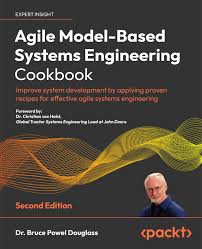Agile Model-Based Systems Engineering: A Comprehensive White Paper
Abstract
This white paper explores Agile Model-Based Systems Engineering (aMBSE), a methodology that integrates the principles of Model-Based Systems Engineering (MBSE) with agile development practices. As industries grapple with increasingly complex systems, constant change, and significant uncertainties, traditional document-centric approaches prove inadequate. aMBSE offers a structured, iterative, and responsive framework for system development, enhancing communication, collaboration, and overall system quality. This paper delves into the core concepts, benefits, practical applications, prevailing challenges, and future trajectory of aMBSE. It also includes a section on hardware-software co-design and highlights how solution providers such as KeenComputer.com and IAS-Research.com can play a strategic role in implementation and success.
Agile Model-Based Systems Engineering and Hardware-Software Co-Design: A Synergistic Approach for Complex Systems
Abstract
This white paper explores the synergy between Agile Model-Based Systems Engineering (AMBSE) and hardware-software co-design, highlighting how their combined application addresses the inherent complexities of modern system development. Traditional approaches often lead to fragmented development paths, particularly between hardware and software teams, resulting in delays, cost overruns, and reduced product quality. AMBSE provides a robust framework for managing evolving requirements and fostering interdisciplinary collaboration through iterative, model-centric practices. When integrated with hardware-software co-design principles, especially through tools and languages like SystemC and its UML profiles, it enables early validation, faster integration, and a unified view of the entire system, from high-level specification to low-level implementation. This paper outlines the core tenets of AMBSE, details the benefits of integrating hardware-software co-design, discusses key enabling technologies, and addresses common implementation challenges.
1. Agile Model-Based Systems Engineering (AMBSE) Explained
Model-Based Systems Engineering (MBSE) is a systematic approach that formalizes models to represent requirements, design, analysis, and validation throughout the entire development lifecycle of engineered systems [INCOSE, 2023]. It aims to streamline traditional document-centric systems engineering practices, enhance development by facilitating information reuse, and consolidate data into a single system model.
Agile methods prioritize improving the quality of engineering work products through frequent feedback, continuous verification, and rapid adaptation to change [Beck et al., 2001]. Agile Model-Based Systems Engineering (AMBSE) applies agile principles to complex, multidisciplinary systems that often involve mechanical, electrical, and software components.
Key characteristics of AMBSE include:
- Managing Change and Uncertainty
- Complexity Management
- Multidisciplinary Collaboration
- Model-Centric Approach
- Executable Models
- Lean Modeling
2. The Imperative of Hardware-Software Co-design
Traditional embedded system development often follows a sequential or "waterfall" approach. Hardware/software co-design allows for concurrent development, reducing time-to-market and enabling early integration and validation [Wolf, 2003]. It focuses on partitioning system functionality between hardware and software components to optimize performance, cost, and flexibility.
3. Bridging the Gap: SystemC, UML Profiles, and Simulation in AMBSE
SystemC is a modeling language based on C++ that facilitates system-level modeling and simulation [Open SystemC Initiative, 2021]. It enables transaction-level modeling (TLM), which abstracts communication and allows high-speed simulation.
Benefits of SystemC and TLM include:
- System-level abstraction
- Early software development
- Co-simulation
- Hardware refinement
UML and SysML Profiles:
UML and SysML provide standardized modeling frameworks. The UML profile for SystemC supports visualization and code generation [OMG, 2021]. SysML is used for requirements and architecture modeling.
Simulation Techniques:
- Hardware-in-the-loop (HIL)
- Virtual modeling/prototyping
- Mathematical modeling and fault injection
4. Enabling Technologies and Tools for AMBSE and Co-design
Key tools include:
- SysML Modeling – Cameo Systems Modeler, IBM Rhapsody
- Simulation Tools – SystemC, MATLAB/Simulink
- Integration Tools – Dassault 3DEXPERIENCE, Siemens Polarion
These tools provide visualization, traceability, verification, and model transformation features [Friedenthal et al., 2014].
5. Addressing Implementation Challenges
Challenges include:
- System complexity
- Stakeholder buy-in
- Tool integration
- Organizational resistance
- User acceptance
Recommended solutions:
- Incremental adoption
- Solution bricks
- Experience-based implementation
- Proof of concept projects
6. Strategic Support by KeenComputer.com and IAS-Research.com
KeenComputer.com brings expertise in system integration, agile DevOps pipelines, and platform engineering. They assist in modeling toolchain setup, SysML modeling workshops, and model transformation for embedded systems. Their cloud infrastructure services also support continuous model validation.
IAS-Research.com specializes in system-level R&D, offering consultation in hardware/software co-design, model refinement, and simulation strategies. Their capabilities in simulation, fault injection, and hardware-in-the-loop testing enable reliability improvements and faster prototyping.
Conclusion
AMBSE and hardware-software co-design form a powerful combination for developing complex, safety-critical, and rapidly evolving systems. With enabling technologies such as SystemC, SysML, and advanced simulation environments, this methodology accelerates development, reduces risk, and improves collaboration. Adoption is feasible through incremental implementation and expert guidance, such as that offered by KeenComputer.com and IAS-Research.com.
References
- Beck, K. et al. (2001). Manifesto for Agile Software Development. Agile Alliance. https://agilemanifesto.org/
- Friedenthal, S., Moore, A., & Steiner, R. (2014). A Practical Guide to SysML: The Systems Modeling Language (3rd ed.). Morgan Kaufmann.
- INCOSE (2023). Systems Engineering Vision 2035. International Council on Systems Engineering.
- OMG (2021). UML Profile for SystemC. Object Management Group. https://www.omg.org/spec/SystemC/
- Open SystemC Initiative (2021). SystemC Language Reference Manual.
- Wolf, W. (2003). A Decade of Hardware/Software Codesign. IEEE Computer, 36(4), 38–43.



